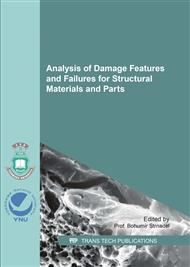p.76
p.82
p.88
p.94
p.99
p.105
p.110
p.116
p.122
Extrapolation of Imaginal Minimum Creep Rate in Compression by a Concept of SATO-Index
Abstract:
Creep characteristics of alloys and compounds have been evaluated mainly by the minimum creep rate or the steady-state creep rate, and by its stress and temperature dependences. In some cases, however, direct comparison of the minimum creep rate or the steady-state creep rate are not practically easy due to difficulties of experiment, i.e., a long duration of primary stage of creep deformation. The minimum creep rates are not always precise representative value, which is directly evaluated from experiments. It should be valuable, if one could estimate the minimum creep rate from creep curve in primary stage. I have proposed a method of quantitative evaluation of creep curve based on the evaluation of strain rate change and its strain dependence during creep [1-3]. The value that reflects a shape of creep curve is named “Strain Acceleration and Transition Objective-Index (SATO-Index)” [4]. SATO-Index and related differential equation show a strain dependence of strain rate and lead entre creep curve by numerical integration. This concept provides quantitative information of shape of each creep curve, and information of the entire creep curve. In this paper, examples of evaluation and extrapolation of creep rate from primary stage in compression are presented. It is concluded that the extrapolation with the concept of SATO-Index reasonably provides imaginal minimum creep rate. Usability of extrapolation of creep curve by the concept is presented.
Info:
Periodical:
Pages:
99-104
Citation:
Online since:
June 2017
Authors:
Price:
Сopyright:
© 2017 Trans Tech Publications Ltd. All Rights Reserved
Share:
Citation:


